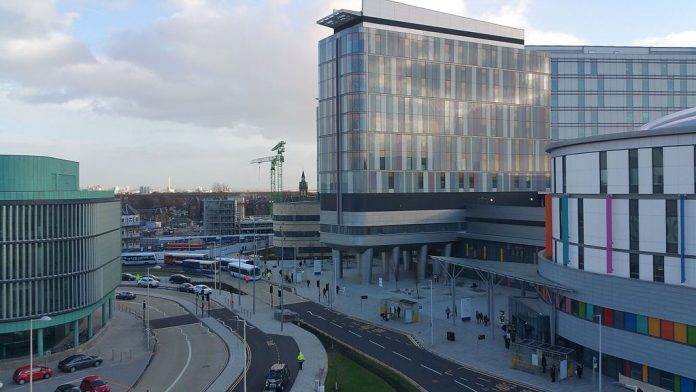There is no clear evidence linking failures in the design, build commissioning and maintenance to avoidable deaths of the Queen Elizabeth University Hospital and Royal Hospital for Children, according to a new report
The Queen Elizabeth University Hospital Independent Review has published its report into the design, build, commissioning and maintenance of the Queen Elizabeth University Hospital (QEUH) and Royal Hospital for Children (RHC).
Chairs Dr Andrew Fraser and Dr Brian Montgomery were asked to examine if the management and execution of the project had adversely impacted on the risk of healthcare associated infection at the NHS Greater Glasgow and Clyde (NHS GG&C) flagship hospital.
While the review concluded the hospitals offer a setting for high quality healthcare for patients, staff and visitors and there is no clear evidence linking failures in its design, build commissioning and maintenance to avoidable deaths, it also revealed cancer patients were exposed to risk .
The report details two main high level findings:
- In the course of the review, through examination of documentation, listening to witnesses, discussion with experts and input from the review’s expert advisers, and site visits, it has not established a sound evidential basis for asserting that avoidable deaths have resulted from failures in the design, build, commissioning or maintenance of the QEUH and RHC;
- The QEUH and RHC combined have in place the modern safety features and systems that one would expect of a hospital of this type. The general population of patients, staff and visitors can have confidence that the QEUH/RHC offers a setting for high quality healthcare.
However, the report also details nine principal findings which are focused on potentially vulnerable groups of patients:
- NHS GG&C has put in place, and is still working on, improvements to the wards where these vulnerable patients are managed. This includes replacement of water, drainage and ventilation systems in order to minimise the risk of infection to patients who will receive their cancer treatment there.
- The QEUH project would have benefited from greater external expertise and greater uptake of internally available expertise to support decision making on the water and air ventilation systems at key points in the design, build and commissioning phases;
- The design of the hospital did not effectively reconcile conflicting aims of energy efficiency and meeting guidance standards for air quality;
- Some of the difficulties encountered with water and ventilation systems were the result of ambiguity concerning the status and interpretation of guidance;
- The level of independent scrutiny and assurance throughout the design, build and commissioning phases was not sufficient;
- Governance of the project during design, build, commissioning and maintenance did not adequately take account of the scale and complexity, and specialist nature of the building project;
- The effectiveness of Infection Prevention and Control (IP&C) advice was undermined by problems within the NHS GG&C IP&C leadership team and internal relationships with the wider IP&C and microbiology cohorts;
- There were deficiencies in the quality and availability of management and technical information relating to the QEUH project, especially relating to the build and commissioning stages. This constrained the Review and continues to hamper effective running of the QEUH/RHC building;
- Communication about QEUH and its problems since opening has been variable ranging from appropriate and effective in relation to clinical communication with patients and families, to inadequate and reactive in relation to external communication about serious problems with the building and possible links to infectious disease events.
Cancer patients exposed to risk
Dr Fraser said: “While the hospital provides a safe healthcare environment for patients, staff and visitors, as the review progressed our findings caused us to focus on those clinical places caring for children and adults with cancers including Leukaemias.
“These specific groups have been exposed to risk that could have been lower if the correct design, build and commissioning had taken place.
“The series of problems and influences that we have identified through the phases of the QEUH project has disrupted treatment for defined groups of patients, meant additional workload for Infection Prevention and Control teams, many clinical groups and hospital management, and diverted resources and attention from the running of this large and complex facility.”
There are a total of 63 recommendations in the report. Three specific areas for future research have also been identified by the Review in relation to supporting similar future projects:
- Air quality in clinical environments
- Water quality in clinical environments
- Rare microorganisms and their clinical significance
‘Avoid repetition of mistakes’
Dr Montgomery commented: “Our focus was on delivering a clinically-focused, forward-looking report that sought both to understand the origins of the situation in Glasgow but more importantly to assess the current state of the hospital and identify learning applicable to future capital projects.
“We found a complex story with a variety of perspectives and views. Undoubtedly and with hindsight, the health board, groups within it, and the design and build contractor could have reached different decisions and produced results that would have reduced infection risk.
“We have tried to concentrate on learning from the experience in a way that will avoid repetition of mistakes and enhance future projects.”
During the course of the Review, over 100 hours of interviews were conducted with medical staff within in NHS, contractors and some of the patients and families who have been affected. Around 3,000 documents and reports have also been scrutinised over two phases.














